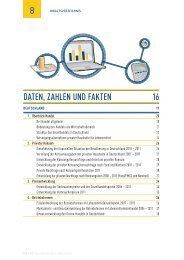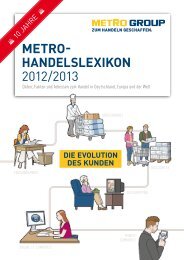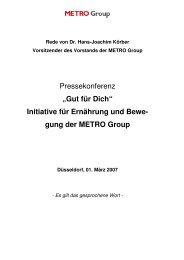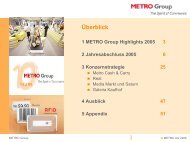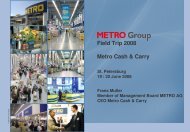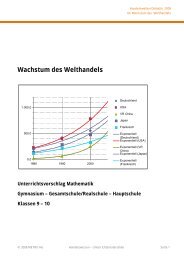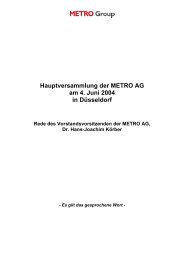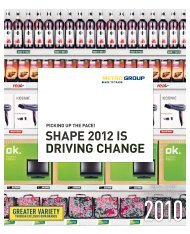pdf (22.8 MB) - METRO Group
pdf (22.8 MB) - METRO Group
pdf (22.8 MB) - METRO Group
Create successful ePaper yourself
Turn your PDF publications into a flip-book with our unique Google optimized e-Paper software.
<strong>METRO</strong> gROUP : ANNUAL REPORT 2011 : BUsiNEss<br />
→ noTes : CapITal ManaGeMenT<br />
Use of discretionary decisions,<br />
estimates and assumptions<br />
The preparation of the consolidated financial statements was<br />
based on a number of discretionary decisions, estimates and<br />
assumptions that had an effect on the value and presentation<br />
of the reported assets, liabilities, income and expenses<br />
as well as contingent liabilities.<br />
Discretionary decisions<br />
The following topics, in particular, required discretionary<br />
decisions in the preparation of these annual accounts:<br />
→ Determination of the consolidation group by assessing control<br />
opportunities (chapter “Consolidation group”). aside<br />
from special purpose entities this concerns, in particular,<br />
investments where control is not necessarily tied in with a<br />
majority of voting rights due to special regulations in the<br />
articles of association<br />
→ Classification of leases as finance lease or operating lease –<br />
including in sale-and-lease-back transactions (no. 20 “Tangible<br />
assets”)<br />
→ Classification of real estate assets as financial investments<br />
(no. 21 “Investment properties”)<br />
→ Classification of financial instruments to the category “held<br />
to maturity” (no. 39 “Book values and fair values according<br />
to measurement categories”)<br />
Estimates and assumptions<br />
estimates and underlying assumptions with significant<br />
effects relate to the following circumstances, in particular:<br />
→ Determination of fair values in the context of first-time consolidation<br />
(chapter “notes on business combinations”)<br />
→ Uniform <strong>Group</strong>-wide determination of useful lives for<br />
limit ed-life assets (no. 13 “Depreciation/amortisation”,<br />
no. 17 “Tangible and intangible assets”, no. 19 “other<br />
intangible assets” and no. 20 “Tangible assets”)<br />
→ event-related impairment tests relating to limited-life<br />
assets (no. 13 “Depreciation/amortisation”, no. 17 “Tangible<br />
and intangible assets”, no. 19 “other intangible assets” and<br />
no. 20 “Tangible assets”)<br />
→ annual goodwill impairment tests (no. 18 “Goodwill”)<br />
→ Recoverability of receivables – particularly receivables<br />
from suppliers (no. 23 “other receivables and assets”)<br />
→ ability to realise tax receivables – particularly from loss<br />
carry-forwards (no. 24 “Deferred tax assets/deferred tax<br />
liabilities”)<br />
→ Measurement of inventories (no. 25 “Inventories”)<br />
→ p. 199<br />
→ Determination of provisions for pensions (no. 32 “provisions<br />
for pensions and similar commitments”)<br />
→ Determination of other provisions – for example, for deficient<br />
rental covers, restructuring and guarantees (no. 33<br />
“other provisions [non-current]/provisions [current]”)<br />
although great care has been taken in making these estimates<br />
and assumptions, actual values may deviate from them in<br />
individual cases. The estimates and assumptions used in the<br />
<strong>Group</strong> accounts are regularly reviewed. Changes are taken<br />
into account at the time new information becomes available.<br />
Capital management<br />
The aim of the capital management strategy of MeTRo GRoUp<br />
is to secure the Company’s continued business operations, to<br />
enhance its enterprise value, to create solid capital resources<br />
to finance its profitable growth and to provide for attractive<br />
dividend payments and capital service.<br />
The capital management strategy of MeTRo GRoUp has<br />
remained unchanged compared to the previous year.<br />
EBiT after Cost of Capital (EBiTaC)<br />
MeTRo GRoUp pursues a value-orientated corporate management<br />
approach based on eBIT after Cost of Capital<br />
(eBITaC). The focus is on the successful deployment of business<br />
assets and the achievement of a value contribution for<br />
MeTRo GRoUp exceeding the cost of capital.<br />
Further information on the development of eBIT after Cost of<br />
Capital is included in the <strong>Group</strong> management report – chapter<br />
3 earnings position – in the section “eBIT after Cost of Capital<br />
(eBITaC)”.<br />
Rating<br />
MeTRo GRoUp’s ratings by the two international agencies<br />
Moody’s and standard & poor’s communicate the Company’s<br />
creditworthiness to existing and potential debt capital investors.<br />
Based on its current ratings, MeTRo GRoUp has comprehensive<br />
access to all debt capital markets.<br />
Detailed information on the MeTRo GRoUp rating can be<br />
found in the <strong>Group</strong> management report – chapter 4 Financial<br />
and asset position – in the “Financial management” section.






